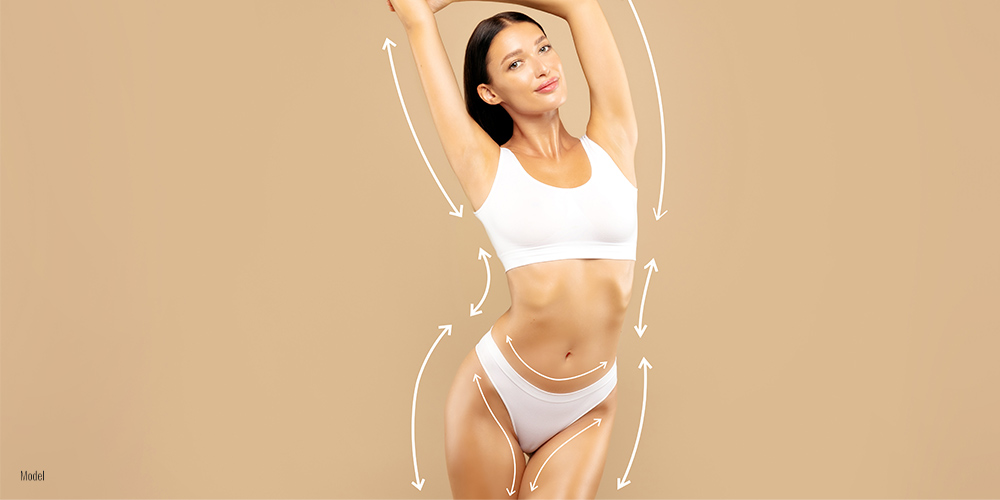How Much Fat Can Be Removed With Liposuction?

Liposuction is generally considered a safe and effective fat removal and body contouring procedure. However, many patients considering this procedure ask how much fat can be removed with liposuction. This blog will discuss the safety limits for surgical fat removal, risks associated with excess fat removal, liposuction candidacy, and the importance of realistic expectations for patient satisfaction.
5 Min Read:
How Is Fat Removed During Liposuction?
Liposuction is one of the most popular plastic surgery procedures due to its ability to eliminate unwanted fat. While there are many techniques used by plastic surgeons today, the basic liposuction procedure is consistent across all methods: small incisions are made at the surgical site, and a cannula, or thin tube, is used to suction out fat. Specifically, stubborn fat is targeted, and the body is sculpted with purpose.
It is important to note that liposuction is a body contouring procedure, not a weight loss strategy. The best candidates for liposuction are already close to their ideal weight but have stubborn fat pockets they struggle to reduce through diet and exercise. Liposuction is ultimately an opportunity for strategic body sculpting, and it’s important that patients understand this before proceeding with an operation.
Is There a Weight Limit on Liposuction?
Generally speaking, there is no weight limit for liposuction candidates. However, many surgeons use a body mass index (BMI) of 30 as the upper limit for liposuction. This is because BMI considers age, sex, and height and is a more accurate measure of body fat distribution.
Patients with a BMI higher than 30 are more at risk for surgical complications and slow healing. These patients are also less likely to see significant results from liposuction. Losing weight is recommended before considering cosmetic surgery. After a patient is closer to their ideal body weight, a more accurate surgical plan can be made to address common side effects of weight loss. For example, many patients experience loose skin after losing a significant amount of weight. In this case, other body contouring procedures, such as a tummy tuck, with or without liposuction, may be more effective.
How Much Fat Can Be Removed with Liposuction?
The medical limit for safely removing fat during a single liposuction procedure is five liters or about 11 pounds of fat. Although an experienced surgeon operating from an accredited facility can safely remove a larger amount of fat than this, these limits are in place for a reason. Exceeding this upper limit can result in increased complications.
What Are the Risks of Removing Too Much Fat During Liposuction?
Exceeding the recommended limit for fat removal during the liposuction procedure can increase the risk of complications. These include:
- Infection: Lengthening surgery time and making larger incisions increase the risk of infection.
- Shock: Removing too much fluid alongside fat can result in dehydration, which can send the body into shock.
- Compromised respiration: Excessive fat removal can cause fluid accumulation, which can make breathing more difficult.
- Fat embolism: A more extensive surgery increases the chance of fat entering the bloodstream.
- Blood clots, seroma, and hematoma: Increased duration of surgery and amount of fat removed simultaneously increase risks for these complications.
To avoid dangerous surgery complications, it is crucial that patients see an experienced, board-certified plastic surgeon who respects safety guidelines and treats patients on a case-by-case basis.
Candidate Factors That Affect How Much Fat Can Be Removed
The ideal candidate for liposuction will meet the requirements for any surgery: they’ll be non-smokers, in good health, and have realistic expectations about the outcome of their procedure.
Additionally, candidates for liposuction should be close to their ideal weight. This way, truly stubborn fat can be targeted instead of excess fat in general, and better results in alignment with the patient’s desired aesthetic are more achievable.
Finally, patients should have firm skin with good elasticity. This minimizes the risk of being left with loose, hanging skin after your procedure. Patients with poor skin elasticity may benefit from another body contouring procedure where excess skin can be removed along with stubborn fat. All of these factors and more can be discussed with your surgeon during your initial consultation.
Setting Realistic Expectations
When planning a body contouring procedure, it’s important to have realistic expectations for the best results. Liposuction is best suited for sculpting, not for general fat removal. If a patient has excess body fat, it is best to lose weight first and then use liposuction to refine their physique. This also gives patients the chance to build a healthier lifestyle in general so that after surgery, they don’t experience an increase in fat again—although it’s true that many patients are motivated to maintain their new physique after surgery.
It’s best to conceptualize liposuction results in terms of inches, not pounds. Liposuction can enhance muscle definition, reshape the body for a slimmer silhouette, and create a sleeker body aesthetic overall.
Losing weight and adopting a positive mindset before your surgery consultation increases the chances that you will be satisfied with your results and new aesthetic. The best results start with realistic expectations.
Interested in Liposuction in Los Angeles?
If you’re considering liposuction, you may have specific questions and concerns. We encourage you to consult a highly qualified and trusted surgeon. Dr. Chia Chi Kao is a board-certified plastic surgeon with decades of experience utilizing the most advanced surgical techniques. He and his team are dedicated to creating a smooth, comfortable patient experience and providing stunning results.
Schedule a consultation with Dr. Kao today to discuss your goals and options. Fill out our online contact form or call (310) 315-9211.


